What is an SQDCI Board?
SQDCI is a framework commonly used in manufacturing and operations to evaluate six critical areas: Safety, Quality, Delivery, Cost, and inventory. These dimensions are systematically tracked to drive continuous improvement and operational excellence.
- Safety: Ensuring a secure work environment by identifying hazards, implementing risk reduction strategies, and maintaining strict safety standards to safeguard employees and prevent accidents.
- Quality: Upholding exceptional product and service quality through continuous monitoring, process refinement, and minimising defects to meet or exceed customer expectations.
- Delivery: Guaranteeing timely and reliable order fulfillment by optimising workflows, reducing lead times, and addressing bottlenecks to ensure customers receive products as promised.
- Cost: Fostering cost efficiency through effective resource management, waste reduction, and process optimisation, ensuring financial sustainability without sacrificing quality or safety.
- Inventory: Managing inventory levels efficiently to ensure the right products are available at the right time, minimising stockouts, reducing excess inventory, and optimising overall supply chain performance.
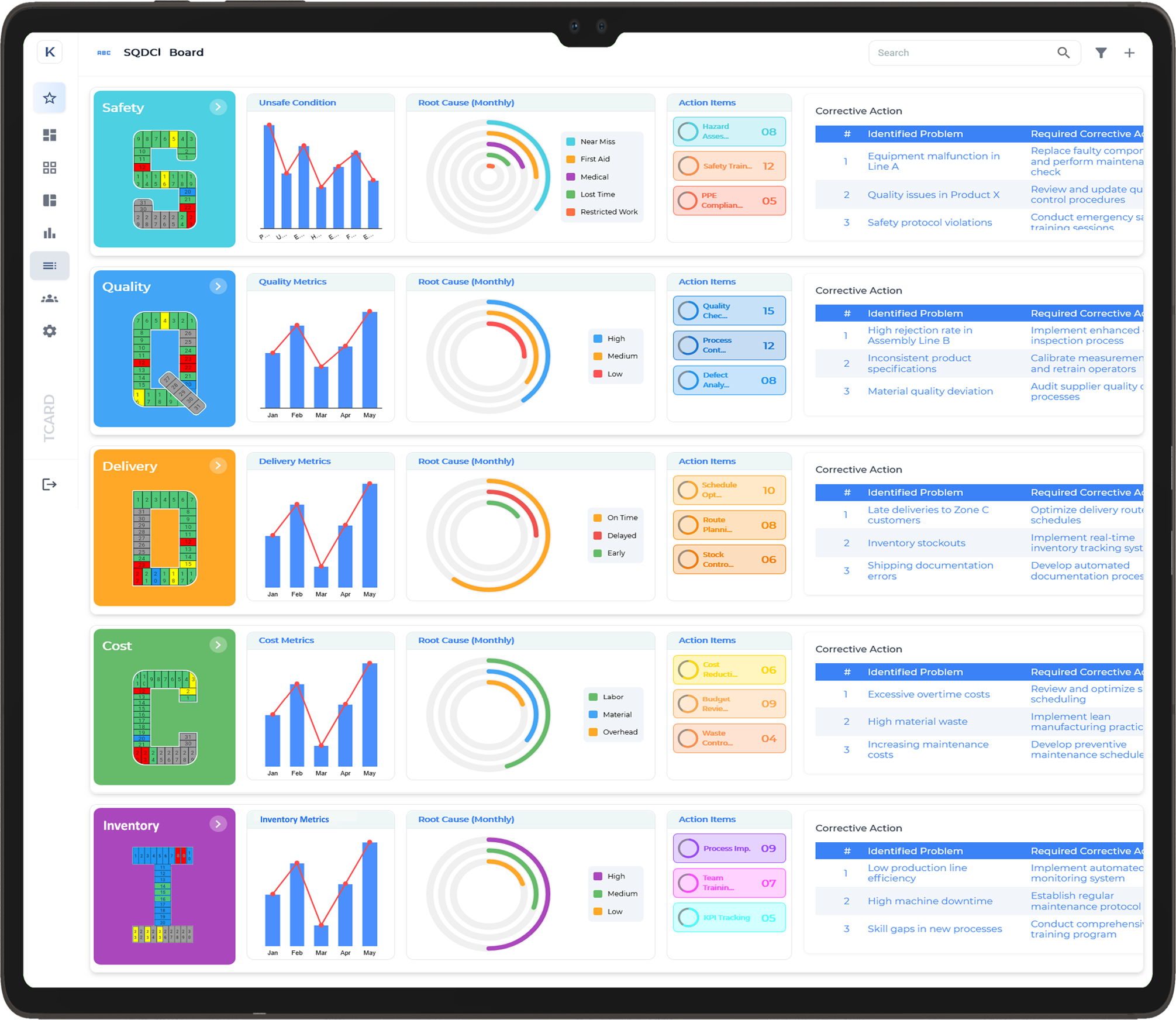
Safety
The Balanced Scorecard plays a critical role in advancing workplace safety by systematically tracking safety-related events. By analysing reported accidents and near-miss occurrences, it offers valuable insights into the effectiveness of safety protocols and highlights key areas for proactive risk mitigation.
- Reported Workplace Accidents
- Documented High-Potential Near-Miss Incidents
- Safety Incidents with Root Cause Analysis Completed
- Conducted Safety Briefings and Training Sessions
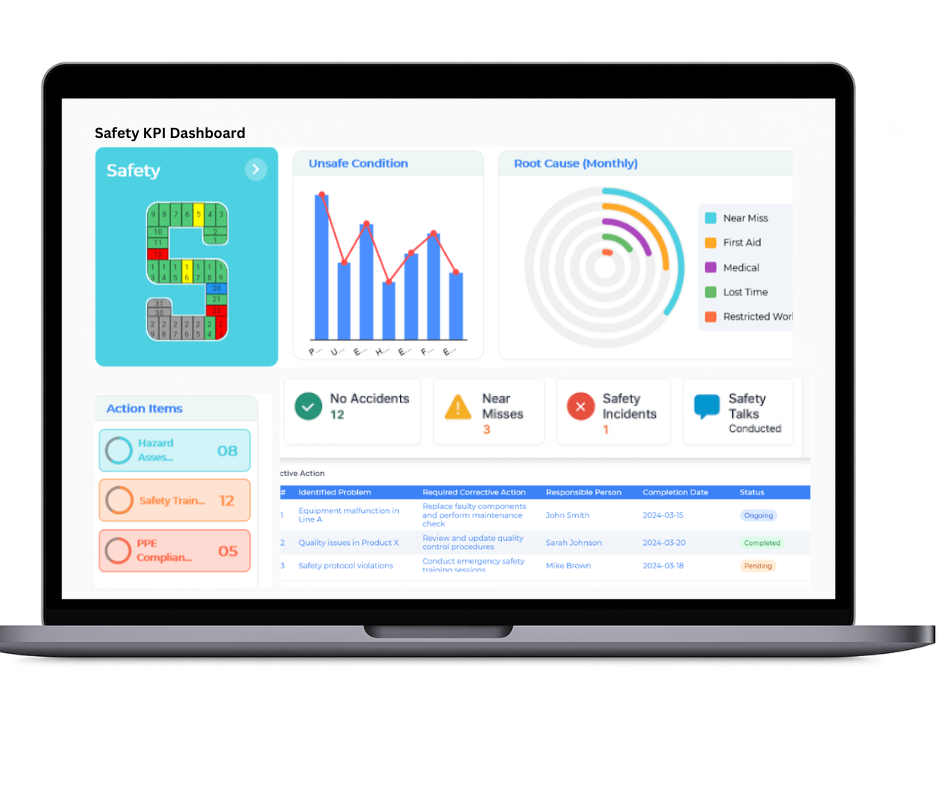
Quality
The Balanced Scorecard’s quality indicators offer a thorough evaluation of both product integrity and process reliability. By monitoring defect rates, inspection outcomes, rework instances, and non-conformance reports—alongside supplier and customer feedback—organisations can reinforce quality control systems and drive continuous improvement initiatives across operations.
- Identified Product Defects
- Failures in Quality Inspections and Functional Testing
- Recorded Rework and Implemented Corrective Actions
- Non-Conformance Reports (NCRs) Issued for Compliance
- Supplier Material Quality Issues Detected and Addressed
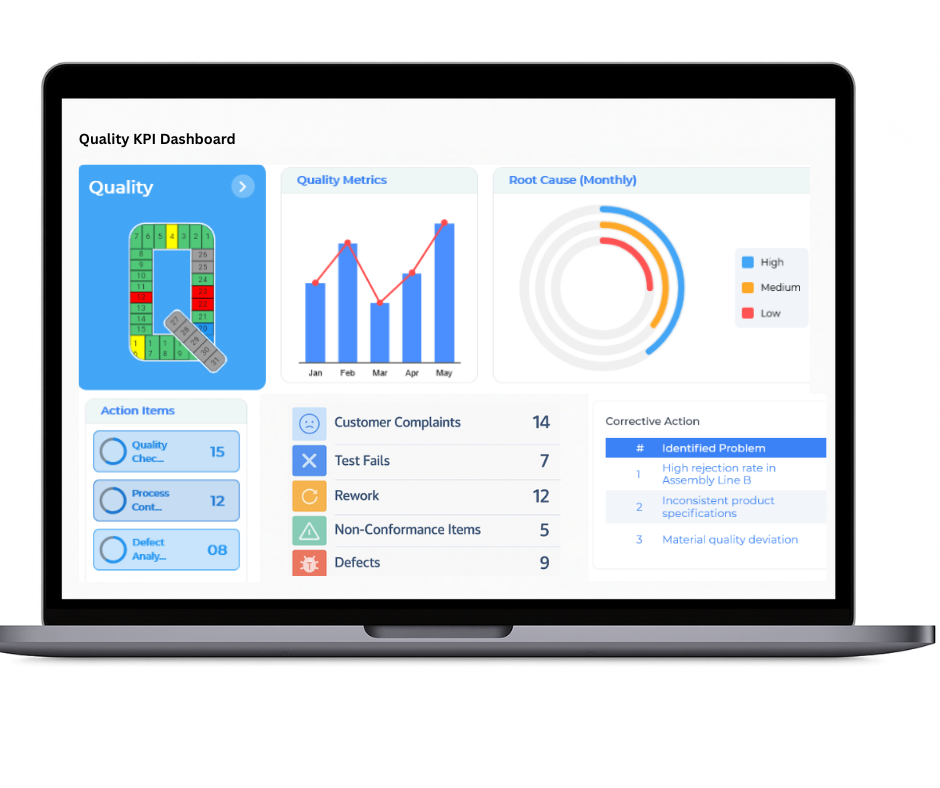
Delivery
The Balanced Scorecard provides an integrated perspective on the delivery lifecycle, ensuring consistent On Time In Full (OTIF) performance from supplier dispatch to customer receipt. By evaluating logistics effectiveness, order accuracy, and inventory movement, it delivers actionable insights that support supply chain optimisation and informed strategic planning.
- Analysis of Late Deliveries and Root Cause Identification
- Monitoring of On Time In Full (OTIF) Delivery Metrics
- Verification of Order Accuracy and Dispatch Reliability
- Review of Warehouse Operations and Inventory Turnover Rates

Cost
Strategic cost management plays a pivotal role in ensuring financial resilience and driving long-term profitability. The Balanced Scorecard enables a structured evaluation of key financial indicators, empowering organisations to uncover cost-efficiency opportunities, enforce budget discipline, and make informed decisions that enhance both operational and fiscal performance.
- Implementation of Targeted Cost Reduction Strategies
- Detailed Tracking and Analysis of Organisational Expenses
- Improvement of Operational Cost-Effectiveness
- Enforcement of Rigorous Budget Compliance Measures
- Strategic Allocation and Efficient Use of Resources
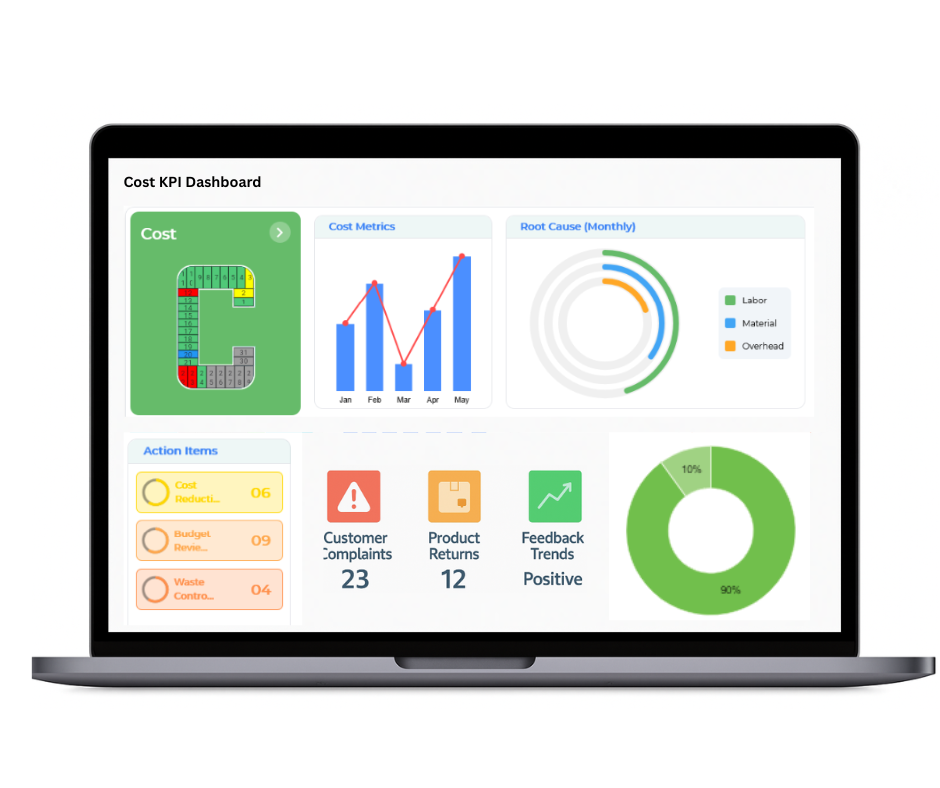
Inventory
Inventory management focuses on optimising stock levels, reducing waste, and ensuring timely availability of materials. It enhances efficiency through accurate forecasting, streamlined storage processes, and careful tracking of inventory movements to support smooth production and customer satisfaction.
- Optimising Stock Levels
- Reducing Waste and Obsolescence
- Ensuring Timely Availability of Materials
- Improving Inventory Turnover
- Enhancing Inventory Accuracy and Tracking
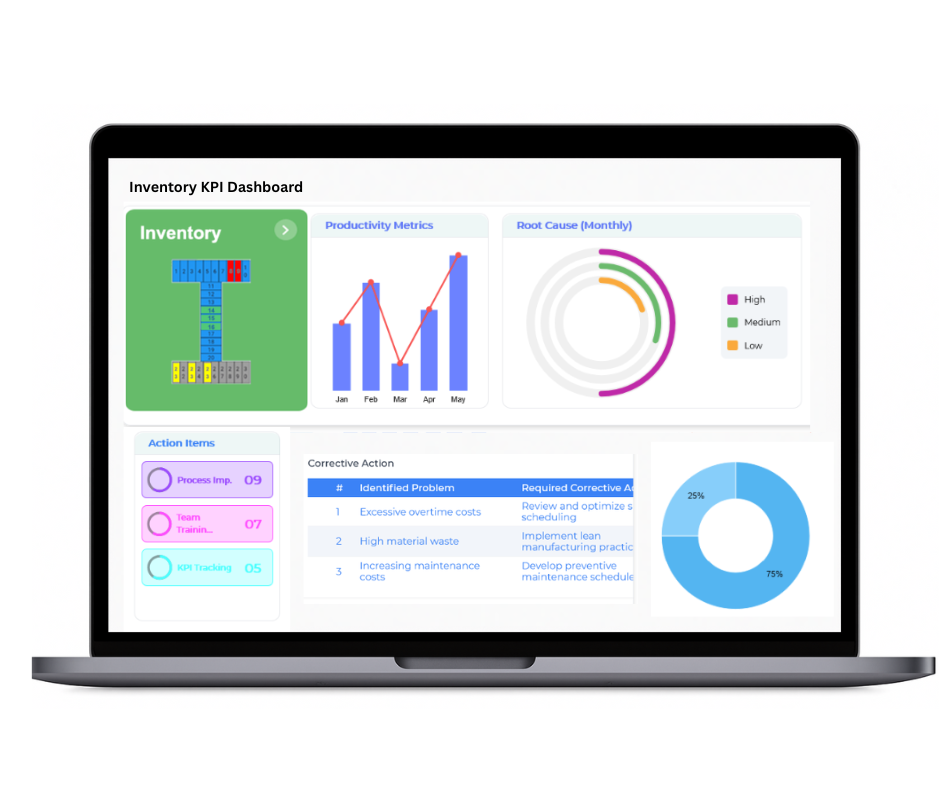
SQDCI Board for Shift Management
- Continuous Performance Monitoring: Tracks key metrics across Safety, Quality, Delivery, Cost, and Inventory to ensure alignment with strategic goals and promote continuous operational improvement.
- Proactive Safety Management: Monitors incidents, near-misses, and safety audits to enhance safety protocols, reduce risks, and maintain a safe working environment.
- Quality Assurance: Measures defect rates, rework trends, and adherence to quality standards to drive continuous improvements in products and processes, ensuring customer satisfaction.
- Optimised Delivery Performance: Assesses On Time In Full (OTIF) delivery, tracks scheduling efficiency, and identifies delays to ensure reliable and timely order fulfillment.
- Cost Control and Resource Efficiency: Focuses on reducing operational costs, optimising resource allocation, and minimising waste to increase profitability and stay within budget constraints.
- Inventory Management: Monitors inventory levels, turnover rates, and stock availability to ensure efficient use of resources, reduce excess stock, and optimise supply chain performance.
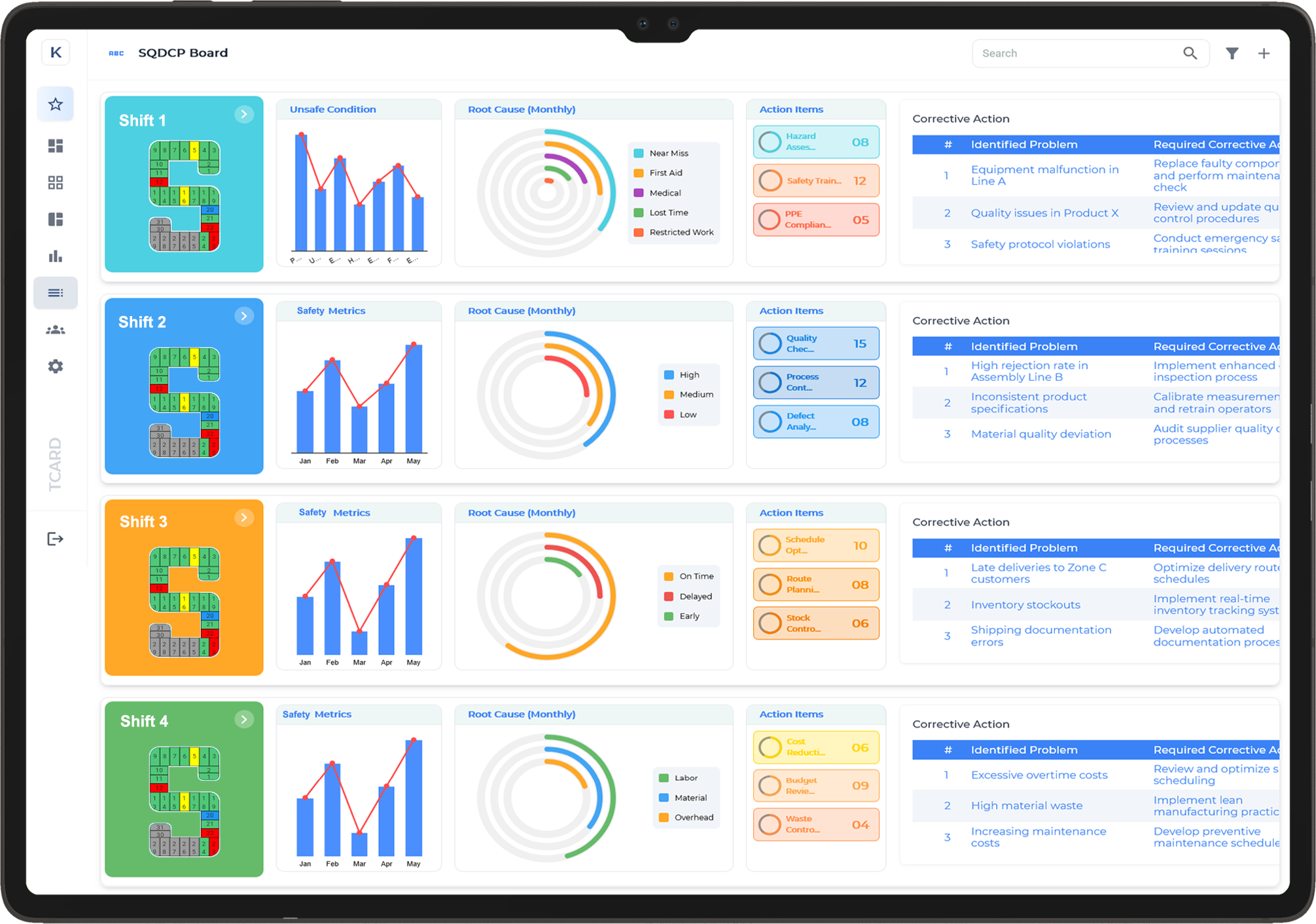
Breaking Down SQDCI: What Each Letter Really Means for Your Team
SQDCI is a structured method used in many workplaces to monitor performance, encourage accountability, and support continuous improvement. Each letter in the acronym represents a key area that teams should focus on daily. Let’s explore what SQDCI stands for and how it helps your team stay on track.
Safety (S)
Safety is always the first priority. This category tracks incidents, near misses, and general safety conditions. Keeping safety at the top ensures that team members feel secure and that risks are quickly identified and managed.
Quality (Q)
Quality refers to the consistency and reliability of work or products. It includes defect rates, rework, and customer feedback. By monitoring quality, teams can improve outcomes and meet expectations more effectively.
Delivery (D)
Delivery covers the ability to meet deadlines and targets. It helps teams keep an eye on production schedules or service delivery timelines, ensuring that commitments are fulfilled on time.
Cost (C)
Cost involves tracking waste, resource use, and expenses. Controlling costs without compromising on quality or speed is vital for staying competitive and efficient.
Improvement (I)
Improvement encourages teams to look for better ways of working. It includes ideas from staff, small process changes, and actions that lead to lasting gains. This promotes a mindset of growth and learning.
SQDCI turns daily goals into visible actions, helping teams focus, communicate better, and improve together.
How an SQDCI Board Enhances Operational Visibility on the Shop Floor
An SQDCI board is a practical tool used on the shop floor to improve visibility and manage performance across key operational areas: Safety, Quality, Delivery, Cost, and Improvement. By displaying real-time data in a clear and visual way, it helps teams stay focused, informed, and aligned with daily goals.
Improves Communication and Focus
One of the main benefits of an SQDCI board is that it improves communication. Staff can quickly see how the team is performing and where attention is needed. It keeps everyone aware of key issues without the need for long meetings or reports.
Supports Quick Decision Making
When problems are visible, action can be taken faster. If there is a safety concern or a delay in delivery, the board shows it clearly. This means team leaders can step in right away, reducing downtime and keeping operations on track.
Encourages Accountability
The SQDCI board helps create a culture of responsibility. Team members can see their own progress and feel motivated to improve. This regular tracking builds a habit of continuous improvement and ownership of results.
Boosts Team Engagement
When workers see the impact of their work every day, they feel more involved. The board creates a shared focus and encourages everyone to contribute to success. It becomes a tool for learning, sharing, and growing together.
Using an SQDCI board is a simple but powerful way to enhance daily operations and drive team performance on the shop floor.
S is for Safety: Creating Safer Workspaces with SQDCI Boards
Safety is the first and most important element of the SQDCI board. It helps teams focus on building a safe and secure working environment every single day. By giving safety its own space on the board, it sends a clear message that people’s wellbeing always comes first.
Daily Checks and Clear Reporting
The safety section of the SQDCI board is used to record daily checks, note any incidents, and highlight areas that need attention. This keeps safety in the spotlight and ensures that nothing is missed. It helps teams act quickly before small issues become serious problems.
Encourages a Safety-First Culture
When safety is discussed every day, it becomes part of the team’s routine. Workers are more likely to follow procedures and report risks when they know safety is being tracked. The board creates a space where safety is always a top priority, not an afterthought.
Supports Training and Awareness
The board can also be used to remind staff of safety rules and promote best practices. By keeping this information visible, it helps team members stay alert and informed. This is a simple yet powerful way to build good habits over time.
With a strong focus on safety, the SQDCI board plays a key role in preventing accidents and creating a healthier workplace. It supports safer operations, one day at a time.
Q is for Quality: Keeping Product Standards High Every Shift
Quality is a vital aspect of any production process, and with an SQDCI board, it becomes easier to maintain high standards throughout each shift. By tracking and reviewing quality metrics daily, teams can ensure that they meet product expectations and customer requirements consistently.
Real-Time Quality Tracking
The quality section of the SQDCI board is designed to capture and display real-time data on product quality. Whether it’s monitoring defect rates, machine performance, or customer complaints, the board helps teams stay on top of quality issues and react quickly to prevent any negative impact.
Preventing Defects and Rework
When quality is visible, teams can spot problems early and take corrective action before defects spread. This proactive approach reduces the need for costly rework and ensures that only top-quality products reach customers. It encourages staff to maintain a high standard throughout their work, preventing errors before they happen.
Promoting Continuous Improvement
Quality isn’t just about fixing problems, it’s about improving processes. The SQDCI board encourages teams to review their work and find ways to improve it. By tracking quality trends, teams can identify root causes of issues and implement solutions that enhance the overall production process.
Incorporating quality into every shift using the SQDCI board helps maintain consistent product standards, drives continuous improvement, and ensures customer satisfaction.
D is for Delivery: Meeting Timelines and Customer Demands with Ease
Delivery is a critical factor in meeting customer expectations. With the SQDCI board, teams can track delivery performance in real-time, ensuring that products are shipped on time and meet customer demands. This visibility helps improve planning and responsiveness, making sure that deadlines are consistently met.
Tracking Delivery Performance
The delivery section of the SQDCI board allows teams to monitor key performance indicators (KPIs) such as lead times, delivery delays, and on-time delivery rates. By tracking these metrics daily, teams can identify potential issues early and take corrective actions to stay on schedule.
Improving On-Time Delivery
Consistently meeting delivery deadlines is essential for maintaining customer satisfaction. The SQDCI board helps highlight any delays or obstacles in the process, enabling the team to quickly address issues before they affect delivery times. By focusing on these key areas, teams can improve efficiency and reduce delays.
Enhancing Customer Satisfaction
On-time delivery is not just about meeting internal goals, but about satisfying customers. By ensuring products arrive when promised, businesses can build trust and loyalty. The SQDCI board helps ensure that delivery performance remains a top priority, leading to improved customer relationships and increased business success.
By tracking delivery on a daily basis with the SQDCI board, teams can effectively meet customer demands, stay ahead of potential delays, and improve overall delivery performance.

C is for Cost: Monitoring and Reducing Operational Costs Efficiently
Cost control is essential for maintaining profitability and ensuring long-term business success. The SQDCI board helps teams track and manage operational costs more effectively, allowing businesses to stay within budget and identify opportunities for cost savings.
Tracking Cost Performance
The cost section of the SQDCI board provides real-time insights into key cost-related metrics such as material costs, labour expenses, and overheads. By regularly reviewing these figures, teams can spot any areas where costs are exceeding expectations and take swift action to reduce them.
Identifying Cost-Saving Opportunities
The SQDCI board allows teams to focus on areas where cost savings can be made. Whether it’s reducing waste, improving resource allocation, or streamlining processes, the board makes it easy to identify inefficiencies and implement solutions that lower operational expenses.
Supporting Budget Control
By monitoring costs on a daily basis, businesses can keep better control over their budgets. The SQDCI board ensures that spending stays aligned with forecasts and that any cost overruns are detected early. This level of transparency supports proactive decision-making and ensures financial targets are met.
With the SQDCI board, businesses can manage operational costs more efficiently, cut unnecessary expenses, and maximise profitability, helping them remain competitive in the market.
I is for Inventory: Smarter Stock Management Through SQDCI Tracking
Effective inventory management is crucial for ensuring smooth operations and reducing costs. The SQDCI board provides a visual, real-time approach to tracking inventory, helping teams stay on top of stock levels and make smarter decisions regarding ordering and storage.
Tracking Stock Levels Accurately
The inventory section of the SQDCI board allows teams to monitor stock levels across different categories. By regularly updating and reviewing this data, businesses can avoid overstocking or running out of critical items, reducing both storage costs and stockouts.
Improving Stock Turnover
Using the SQDCI board to track inventory helps improve stock turnover rates. By identifying slow-moving items or excess stock early, businesses can take action to optimise their inventory. This reduces waste, frees up valuable storage space, and ensures that resources are allocated more efficiently.
Minimising Wastage and Reducing Costs
With clear, up-to-date visibility of inventory, businesses can better manage product lifecycles and reduce wastage. The SQDCI board highlights potential issues like obsolete stock or over-ordering, helping teams take action before these lead to unnecessary costs.
By using the SQDCI board for inventory management, businesses can streamline their stock control processes, reduce costs, and improve overall operational efficiency.
Why More Teams Are Moving to SQDCI Boards for Daily Performance Checks
In today’s fast-paced business environment, maintaining high performance across all areas is crucial. More and more teams are turning to SQDCI boards to track their daily performance, as they provide a simple, effective way to monitor key metrics and stay aligned with organisational goals.
Real-Time Performance Monitoring
The SQDCI board allows teams to view real-time data on crucial performance indicators such as Safety, Quality, Delivery, Cost, and Inventory. By having all of this information in one place, teams can quickly identify areas that need attention and take immediate action to address any issues.
Improved Communication and Collaboration
One of the main reasons teams are adopting SQDCI boards is the enhanced communication they promote. By keeping everyone on the same page, these boards make it easier for team members to share updates, highlight concerns, and discuss improvements. This leads to better collaboration and quicker problem-solving.
Fostering a Culture of Continuous Improvement
Using SQDCI boards for daily performance checks encourages a culture of continuous improvement. Teams can quickly identify patterns, learn from mistakes, and implement solutions to improve efficiency. This daily reflection helps teams stay focused on progress and pushes them to do better each day.
Ultimately, SQDCI boards provide a clear, efficient way to track performance and ensure teams stay on track. As a result, they are becoming an essential tool for businesses looking to improve productivity and achieve their goals.
Using SQDCI Metrics to Empower Frontline Decision-Making
Empowering frontline workers with the right data is key to improving decision-making and operational efficiency. SQDCI metrics provide a clear, easy-to-understand framework for tracking performance, enabling frontline teams to make informed decisions in real time and drive improvements across various areas.
Data-Driven Decision-Making at the Frontline
With SQDCI metrics, frontline teams can access key performance indicators (KPIs) in areas such as Safety, Quality, Delivery, Cost, and Inventory. This real-time data allows workers to see how their actions impact overall performance, giving them the tools to make quick, informed decisions that can immediately improve outcomes.
Improving Responsiveness and Agility
By using SQDCI boards to monitor daily performance, teams can identify issues before they escalate. This enables quicker responses to potential problems, such as delays or quality issues, reducing downtime and improving efficiency. Empowering workers to make these decisions directly leads to more agile operations and better customer satisfaction.
Promoting Accountability and Ownership
When frontline workers have access to relevant performance data, they are better equipped to take ownership of their work. The transparency of SQDCI metrics fosters a culture of accountability, as employees can clearly see the results of their decisions and understand how they contribute to overall success.
By leveraging SQDCI metrics, businesses can unlock the potential of their frontline teams, improving decision-making, enhancing operational performance, and driving continuous improvement across the organisation.
The Role of Visual Management in an SQDCI Board Setup
Visual management is a powerful tool that enhances communication and decision-making in any operational environment. When integrated into an SQDCI board setup, it plays a crucial role in making performance metrics clear and accessible, enabling teams to take immediate action and drive improvements.
Clear and Instant Visibility
The primary role of visual management is to provide clear, at-a-glance visibility of key performance indicators (KPIs). In an SQDCI board setup, visual elements such as colour-coded charts, graphs, and progress bars help teams quickly identify areas of concern, track daily performance, and ensure alignment with organisational goals.
Encouraging Daily Engagement
By presenting data visually, SQDCI boards encourage daily engagement with performance metrics. Workers and managers can easily review metrics on Safety, Quality, Delivery, Cost, and Inventory, promoting proactive problem-solving and timely decision-making. This level of visibility ensures that no issue goes unnoticed, leading to quicker resolutions and improved productivity.
Fostering Accountability and Ownership
Visual management helps to foster a sense of accountability among teams. When key metrics are displayed in real time, everyone can see the impact of their work. This transparency encourages workers to take ownership of their responsibilities, contributing to a culture of continuous improvement.
Incorporating visual management into an SQDCI board setup enhances clarity, encourages timely action, and empowers teams to improve performance and achieve organisational goals more effectively.
Daily Huddle Meetings with SQDCI Boards: Keeping Everyone Aligned
Daily huddle meetings are an essential part of maintaining alignment and focus within teams. When combined with an SQDCI board, these meetings become even more powerful, providing a clear framework for reviewing key performance indicators (KPIs) and ensuring that everyone is on the same page for the day ahead.
Structured and Focused Discussions
Using the SQDCI board in daily huddles helps structure discussions around key areas such as Safety, Quality, Delivery, Cost, and Inventory. This visual tool provides a central point of reference, allowing teams to quickly identify areas of concern and focus on the most critical issues. By using the board as a guide, meetings remain focused and efficient, with all relevant data clearly displayed.
Boosting Communication and Collaboration
Incorporating SQDCI boards into daily huddles promotes open communication and collaboration. Team members can easily share updates, highlight challenges, and discuss potential solutions. The board encourages active participation from everyone, creating a culture of transparency and teamwork. With clear, visual data at hand, it’s easier to make informed decisions and resolve issues faster.
Staying Aligned with Goals
Daily huddle meetings, supported by the SQDCI board, ensure that teams stay aligned with both short-term and long-term goals. By reviewing performance metrics every day, teams can adapt quickly to changes, keep track of progress, and stay focused on achieving their objectives.
Incorporating SQDCI boards into daily huddles helps teams remain aligned, proactive, and engaged, ultimately driving better performance and smoother operations.
How SQDCI Boards Drive Lean Thinking and Continuous Improvement
SQDCI boards play a pivotal role in promoting lean thinking and driving continuous improvement within an organisation. By providing a clear, visual overview of key performance metrics, these boards enable teams to identify inefficiencies, eliminate waste, and focus on optimising processes for better results.
Fostering a Culture of Continuous Improvement
One of the core principles of lean thinking is the pursuit of continuous improvement, or "kaizen". SQDCI boards support this by making performance data easily accessible, allowing teams to quickly identify areas that need attention. With real-time insights into Safety, Quality, Delivery, Cost, and Inventory, teams can continuously evaluate their processes and make data-driven decisions to improve performance.
Visualising Waste and Inefficiencies
SQDCI boards help teams visualise inefficiencies and waste in real time. For example, if a quality issue or delay in delivery is affecting performance, the board highlights it immediately. This visibility enables teams to respond quickly, implement corrective actions, and eliminate the root causes of inefficiencies, thus supporting the principles of lean manufacturing.
Empowering Teams for Problem-Solving
By empowering frontline teams with the right information, SQDCI boards enable them to take ownership of improvements. Teams can track progress, highlight bottlenecks, and discuss potential solutions during daily huddles or team meetings, fostering a proactive approach to problem-solving and driving continuous improvement.
Overall, SQDCI boards are a key tool in implementing lean thinking, helping teams optimise performance, reduce waste, and create a culture of continuous improvement across the organisation.
From Manual to Digital SQDCI Boards: What’s Right for Your Organisation?
As businesses evolve, so too do the tools they use to track performance. While manual SQDCI boards have long been a staple in operational management, many organisations are now making the shift to digital boards. But how do you know which option is right for your organisation? Understanding the benefits and challenges of each can help guide your decision.
The Benefits of Manual SQDCI Boards
Manual SQDCI boards offer a simple, low-cost solution that’s easy to implement. They are often used in smaller teams or environments where real-time updates aren’t as critical. These boards allow teams to visually track key performance metrics such as Safety, Quality, Delivery, Cost, and Inventory, making it easy to spot issues and make adjustments on the spot. However, manual boards can become cumbersome as teams grow, and tracking historical data or sharing updates across multiple locations can be challenging.
The Advantages of Digital SQDCI Boards
Digital SQDCI boards offer a range of benefits, including real-time data tracking, remote access, and the ability to store historical performance data. These boards allow for quick updates and make it easier to analyse trends over time. For larger teams or organisations spread across multiple locations, digital boards provide the flexibility needed to keep everyone aligned. Additionally, they can integrate with other software systems, allowing for automated data updates and seamless communication across departments.
Which is Right for Your Organisation?
The decision between manual and digital SQDCI boards depends on the size of your organisation, your need for real-time data, and your budget. Smaller teams with simple processes may find manual boards sufficient, while larger organisations or those with more complex workflows may benefit from the efficiency and scalability of digital boards.
Ultimately, both options offer valuable tools for performance management. The key is to assess your organisation's needs and choose the solution that best supports your goals.
Best Practices for Implementing an SQDCI Board in Manufacturing or Services
Implementing an SQDCI board effectively can significantly improve operational performance in both manufacturing and service sectors. However, to ensure it delivers maximum value, it’s important to follow best practices during the setup and use of the board. Here are key steps to consider when implementing an SQDCI board in your organisation.
Define Clear Objectives
Before setting up an SQDCI board, it’s crucial to define the specific objectives you aim to achieve. Whether you’re focusing on improving Safety, Quality, Delivery, Cost, or Inventory, understanding the goals for each area will help you tailor the board to track the most relevant metrics. Clear objectives guide the design of the board and ensure it serves the needs of your team.
Ensure Real-Time Data Updates
For an SQDCI board to be effective, it must provide real-time updates that reflect the current status of performance metrics. Whether you opt for a manual or digital board, make sure data is updated regularly to allow for timely decisions and proactive issue resolution. This can be particularly important in fast-paced environments where delays in data updates can lead to missed opportunities for improvement.
Promote Team Involvement
Involve frontline employees in the setup and use of the SQDCI board. Their insights into operational challenges can help you identify the most critical metrics and ensure the board addresses real, everyday issues. Encouraging teams to take ownership of the board’s maintenance and updates fosters a sense of accountability and empowers employees to drive continuous improvement.
Review and Adjust Regularly
Once the board is in place, ensure it is regularly reviewed to assess its effectiveness. Use team meetings or daily huddles to discuss performance metrics, identify areas for improvement, and adjust processes accordingly. Continuously reviewing the board’s layout and performance metrics ensures that it remains relevant and aligned with evolving business goals.
By following these best practices, organisations can make the most of their SQDCI boards, improving visibility, enhancing decision-making, and driving sustained performance improvements.
Real-World Examples of SQDCI Boards Delivering Tangible Results
SQDCI boards have proven to be effective tools in a variety of industries, helping organisations track performance, improve processes, and achieve their goals. Here are a few real-world examples where SQDCI boards have delivered tangible results in both manufacturing and service sectors.
Manufacturing: Improving Safety and Quality
In a large manufacturing plant, the implementation of an SQDCI board focused on Safety and Quality led to significant improvements. By tracking safety incidents and quality defects in real time, management was able to quickly identify patterns and address potential hazards or issues in production. As a result, the company saw a 25% reduction in workplace accidents and a 15% improvement in product quality within the first quarter of using the board.
Service Industry: Streamlining Delivery and Customer Satisfaction
In a service-based business, an SQDCI board was used to monitor Delivery performance and Customer Satisfaction. By tracking on-time delivery rates and gathering customer feedback regularly, the company was able to quickly address delays and implement improvements. This led to a 20% increase in on-time deliveries and a 30% boost in customer satisfaction scores, resulting in greater customer retention and higher sales.
Healthcare: Reducing Costs and Enhancing Inventory Management
A hospital implemented an SQDCI board to track Cost and Inventory management, particularly focusing on the efficiency of medical supplies. By reviewing inventory levels and cost metrics regularly, the hospital was able to reduce wastage and optimise its supply chain. This led to a 12% reduction in supply costs and a more efficient use of resources, improving overall operational efficiency.
Logistics: Improving Cost Efficiency and Delivery Performance
In a logistics company, an SQDCI board was used to monitor Delivery performance and Costs, ensuring that drivers adhered to schedules and fuel consumption was optimised. This resulted in a 15% reduction in delivery delays and a 10% decrease in fuel expenses, directly impacting the company’s bottom line.
These examples demonstrate the practical benefits of implementing an SQDCI board in various industries. By providing clear visibility into key performance metrics, these boards help organisations make data-driven decisions, improve processes, and achieve measurable results.
Components of an SQDCI Board
Color-Coded Performance Indicators
To quickly assess performance, teams use a color-coding system:
- Green: Target met, no issues.
- Yellow: Minor deviations, requiring attention.
- Red: Critical issues, requiring immediate action.
Daily Metrics Tracking
Each SQDCI category is assigned measurable KPIs, which teams update regularly to reflect current performance.
Corrective Action Plans
Whenever an issue arises, it is documented along with an assigned owner and a timeline for resolution.
Team Ownership
Operators, supervisors, and managers contribute to board updates, ensuring team engagement and responsibility.
How to Use an SQDCI Board
Step 1: Setting Up the Board
Define KPIs for each SQDCI category based on business goals. Position the board in an accessible area for team visibility.
Step 2: Daily Performance Updates
Teams update performance data at the beginning of each shift, marking status changes using the color-coded system.
Step 3: Conducting Daily Stand-Up Meetings
Supervisors and team members review the board, discuss flagged issues, and assign corrective actions.
Step 4: Trend Analysis
Regular analysis of data helps identify patterns and areas for long-term improvement.
Step 5: Implementing Continuous Improvement
Innovation-related improvements are documented, tested, and integrated into workflows.
Benefits of an SQDCI Board
Improved Visibility: Teams gain real-time access to operational performance data.
Enhanced Problem-Solving: Root causes of issues are identified and addressed quickly.
Increased Accountability: Clear assignment of responsibilities ensures timely action.
Fostering Innovation: Teams are encouraged to suggest and implement improvements.